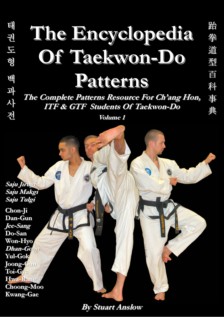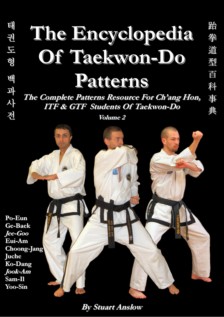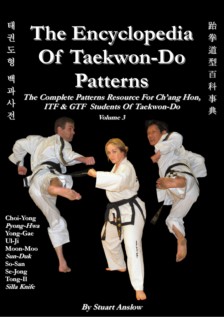The Encyclopedia Of Taekwon-do Patterns The Complete Patterns Resource For Ch’ang Hon, ITF & GTF Students Of Taekwon-Do Vols 1, 2 & 3 The new books by Stuart Anslow |
The Encyclopedia Of Taekwon-do Patterns The Complete Patterns Resource For Ch’ang Hon, ITF & GTF Students Of Taekwon-Do Vols 1, 2 & 3 The new books by Stuart Anslow |
Recommended Reading |
Recommended Reading |


LINKS |
To Order A Single Volume Or The Complete Set -- Click Here-- |
These martial art ‘forms’, as many call them, are comprised as Gen. Choi would say,
of “various fundamental movements, most of which represent either attack or
defence techniques, set to a fixed and logical sequence”. According to Gen. Choi
training with these patterns will improve flexibility of your movements, build
your muscles, assist with body shifting, help with one’s breathing, develop
fluid motions and allow for rhythmic movements that are aesthetically pleasing.
Finally he felt that patterns provide a “critical barometer in evaluating an individual’s
technique”. Training with the patterns has become an important part of Taekwon-Do’s syllabus for both promotion and competition. Additionally to not only helping to develop technical proficiency, diligent study and practice of these patterns is needed to help the student grow their mental or spiritual discipline. Adherence to the strict instruction of one’s master instructor or the established criteria of competition allows the student numerous opportunities to enhance character traits necessary to build discipline. Knowledge of the meanings of the patterns and the great Korean patriots and significant events in Korean history that they are named after, also affords each student with fine examples to mentor and strive towards, which assists in developing their individual character further. General Choi not only developed the original Taekwon-Do patterns, but he had the foresight to name them after these figures and events so details of Korea’s history and culture would not only be spread around the world, but would be safeguarded against eradication, in case Korea ever suffered under the brutality of an occupying force again, as they were disseminated globally through his Taekwon-Do. These patterns became an important part in making his Taekwon-Do a distinctly Korean martial art. They, like other martial art forms, Katas, Poomsae or Hyungs, help to define their art. The Chang Hon patterns are like Gen. Choi’s signature. Signatures are unique and much like another patriot, John Hancock, who signed America’s Declaration of Independence in a large, bold way, allowing him to stand out during their late 18th century struggle for freedom. This is his fingerprint, his legacy, what he left behind as a gift for mankind for all of eternity. The 24 patterns he left us with reflect 24 hours, one day, or all of his life that he lived in the 20th century and into the next millennium. These books cover not only the 24 patterns left to us by General Choi, but also Ko-Dang as well. This Tul, at times referred to as the lost pattern is contained within this work. The only other books to do this to my knowledge is the Patterns Handbook published by the United States Taekwon-Do Federation, which contains text instructions only and Hee Il Cho’s Volume 3. The 39 moves of this pattern however are captured in this work with both photos and diagrams, in addition to the all important written instructions. Of course the older books written by General Choi contained just four of them in 1959 and only 20 in 1965. His other later books published through the International Taekwon-Do Federation (ITF) contained just 24, either with Ko-Dang or Juche, with none of them containing the detail that is presented here. There have been other books on the Chang Hon patterns like the series of 5 books by Jhoon Rhee that only covered 9 color belt Hyungs up to red belt level. Hee Il Choi’s series of 3 books still contain only the first 20 patterns developed by Gen. Choi and his soldiers. Never before have all 25 been covered in such detail. Additionally the 3 fundamental exercises required for promotion and advancement 4 direction punch, 4 direction block for 10th gup white belt beginners and 4 direction thrust for 2nd kup red belts are included as well. These books also contain the Silla Knife pattern created by Grandmaster Kim Bok Man. Grandmaster Kim was a Sgt-Major under the command of Gen. Choi in the ROK Army. He was a member of the historic Taekwon-Do demonstration team that first took Taekwon-Do |
Foreword By Master George Vitale, 8th Degree |
It is my pleasure to write this foreword for Mr. Stuart Anslow’s latest gem, a book
series on Taekwon-Do patterns. Mr. Anslow, a talented and dedicated martial
artist and black belt instructor has made a name for himself in the martial
art world as a steadfast defender of Taekwon-Do’s ability to provide sound self
defence skills to its students. The basis for his claim, which I steadfastly
agree with, is to return to the roots of Taekwon-Do, when it was developed in
the Republic of Korea’s Army as an effective military means for self defence.
This was during a period when strong defence skills were necessary to survive on
the rough streets of Korea and during the protracted periods of war time that
Korea was engaged in. The effectiveness of this new Korean martial art, a compilation
of the fighting systems available at the time (1950s and 60s) has been
well documented on the field of battle as well as reported in the periodicals of
the day. The soldiers who originally developed this Korean martial art were led by a legendary Major-General and Ambassador Choi Hong Hi, one of the founding members of the ROK Army. Gen. Choi over his lifetime (1918-2002) devised 25 patterns, called Tuls in Korean. |
abroad when they toured Vietnam and Taiwan in 1959. Sgt-Major Kim also went to Malaysia
in 1963 where he helped General Choi finalize 16 of the Chang Hon Tuls.
He was responsible for helping Taekwon-Do spread through out South East Asia.
This pioneer was also a founding member of the ITF in 1966 and now teaches his
art of Chun Kuhn Do. Finally Mr. Anslow’s series of books feature the patterns devised by the late Grandmaster Park Jung Tae, often referred to as the People’s Master and used by the Global Taekwon-Do Federation (GTF). It is believed that no other book contains these patterns. So this work is a great resource for GTF students, who also do the ITF patterns as well. Grandmaster Park was a key right hand man to General Choi throughout the 1980s, as the former ITF Secretary General and Chairman of the ITF Instruction Committee. He was instrumental in creating Juche, Taekwon-Do’s final pattern and the most Korean of all of the original Tuls. Stuart has included Kihap points as emphasized by various groups or instructors. His true history section helps to sort out the confused and muddied story of Taekwon-Do’s development. He takes the time to credit the original pioneers for some of their many contributions, so his books are most inclusive, as should be and as few, if any are. The studies written by Master Paul McPhail, one of the ITF’s most technically savvy researchers, will help students understand the ways of motion, that are often confusing and hard to understand. As an instructor Stuart Anslow teaches and focuses on Chang Hon Taekwon-Do. He does not get bogged down by organizational constraints or the politics that often can be in play. Therefore his work transcends these boundaries. In the words of a Pioneer Grandmaster Rhee Ki Ha, instrumental in assisting with the development and the spread of Taekwon-Do worldwide and the first person promoted to IX Dan (9th Degree) by the principle founder, Gen. Choi, we are ITF, “International Taekwon-Do Family”. These works, along with his previous work are major steps forward in uniting this original Taekwon-Do family. Unity within the Tae Kwon Do community is long overdue. When one studies this recent project and his past contributions, it becomes increasingly clear that we have so much more in common than that which separates us. We are after all one Art and in addition we share aspects with all Martial Arts. Unity among “ITF stylists” should come first, followed by all Tae Kwon Do groups. Then it will be easier to see how we are all “just martial artists”. These books, like Mr. Anslow’s previous works on the hidden applications of the patterns is a must have for any serious martial artist. |


